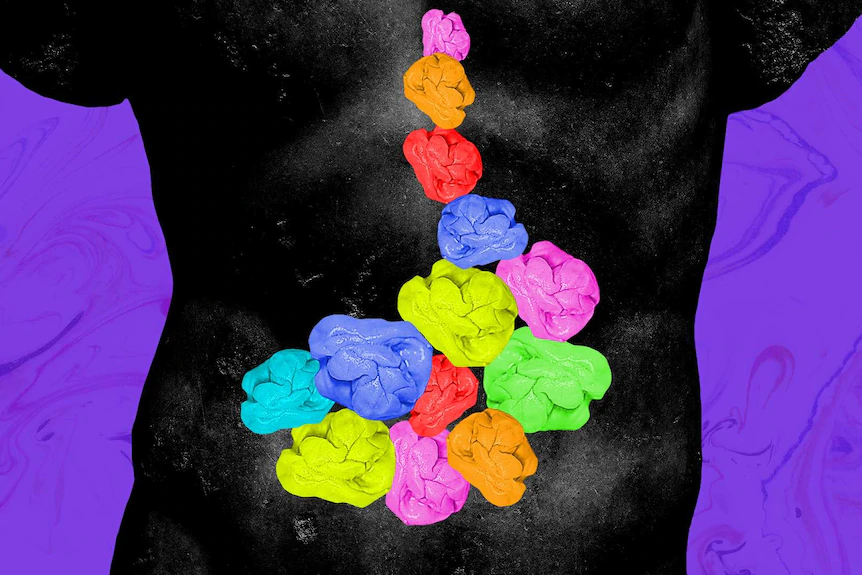People tend to believe whatever they hear, especially when it sounds like something that’s backed by science. That’s how the Flat Earth theory and other conspiracies became some of the most talked about topics in the world. But thanks to the users of Reddit, we’re seeing tons of these popular science myths debunked by actual science. What would we do without the world of Reddit? We’d probably still believe that we can’t swim after we eat, that we only use 10% of our brain, and that coffee can sober us up. Many of these false stories spread through circular reporting. The more people talk about and believe it in, the faster it spreads, until suddenly, everyone in the world believes false information. Unless it’s backed by science, it’s probably false. If you were set on believing one of these theories, it’s time you change your mind and start looking at real scientific facts backed by actual experiments.
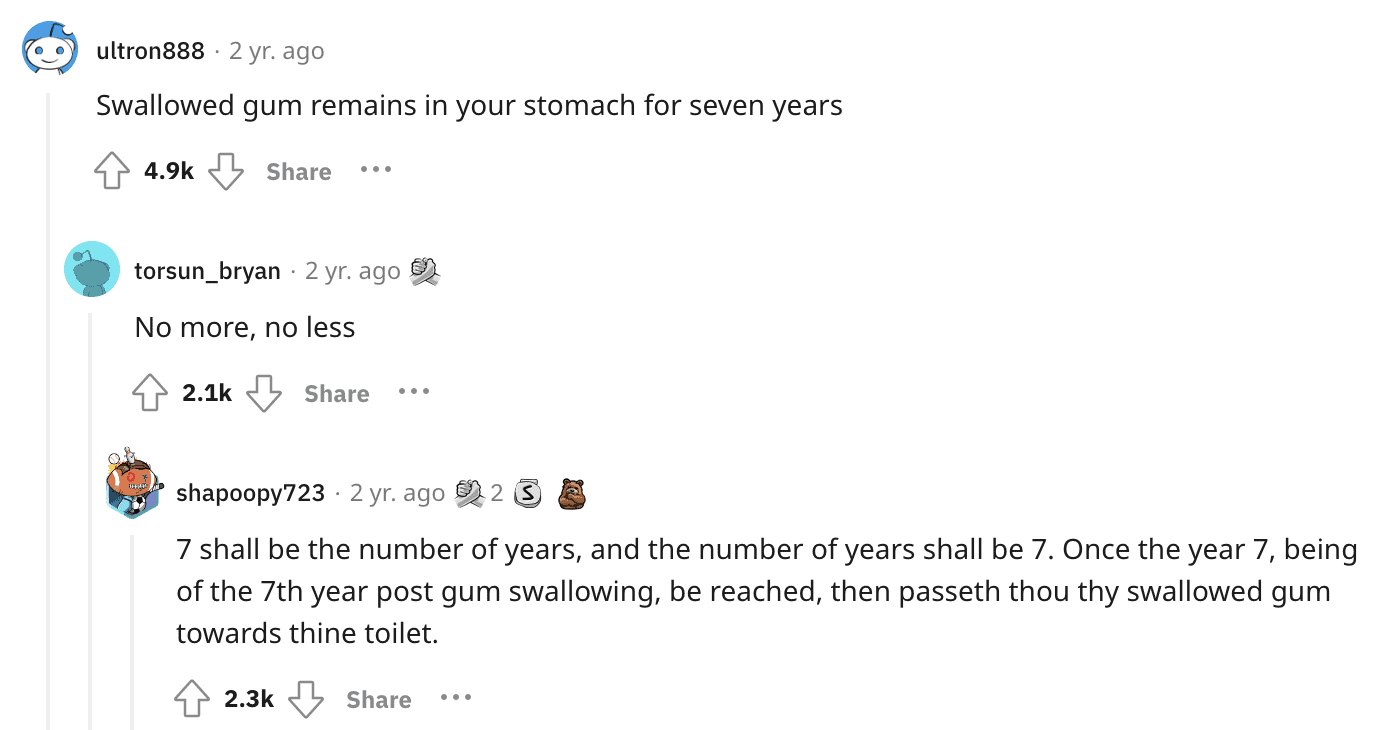
Gum Doesn’t Stay In Your System For Seven Years
How often have you heard that swallowed gum stays in your stomach for seven years? Probably too many to count. That piece of gum you swallowed five years ago isn’t still in your system. Your stomach lining doesn’t absorb the ulcer. Your body processes it just as it processes every other type of food, though it’s more difficult to digest than normal food. According to Dr. McGreal, “the gum base is insoluble, just like the fiber base of raw vegetables, corn, popcorn kernels, and seeds. Our bodies do not possess digestive enzymes to specifically break down gum base.” He has yet to see gum still in the system from seven years ago, luckily debunking this popular science myth we learned when we were children. Even in the most extreme cases, like someone with a paralyzed stomach, gum still wouldn’t lodge itself into the stomach for seven years (Ultron888).

Lemmings Don’t Commit Suicide
Just like any other animal on the planet, Lemmings, which are rodents that look similar to mice, want to live. They’re not suicidal, and this popular science myth spread throughout the whole world. It started when producers were filming a Disney nature documentary, White Wilderness. They herded the Lemmings off of cliffs, and the misconstrued idea stuck. According to wildlife biologist Thomas McDonough, “it’s a complete urban legend. I think it blew out of proportion based on a Disney documentary in the ’50s, and that brought it to the mainstream.” The entire scene was staged and filmed at certain camera angles to make it look like they were committing suicide (Graeuk).
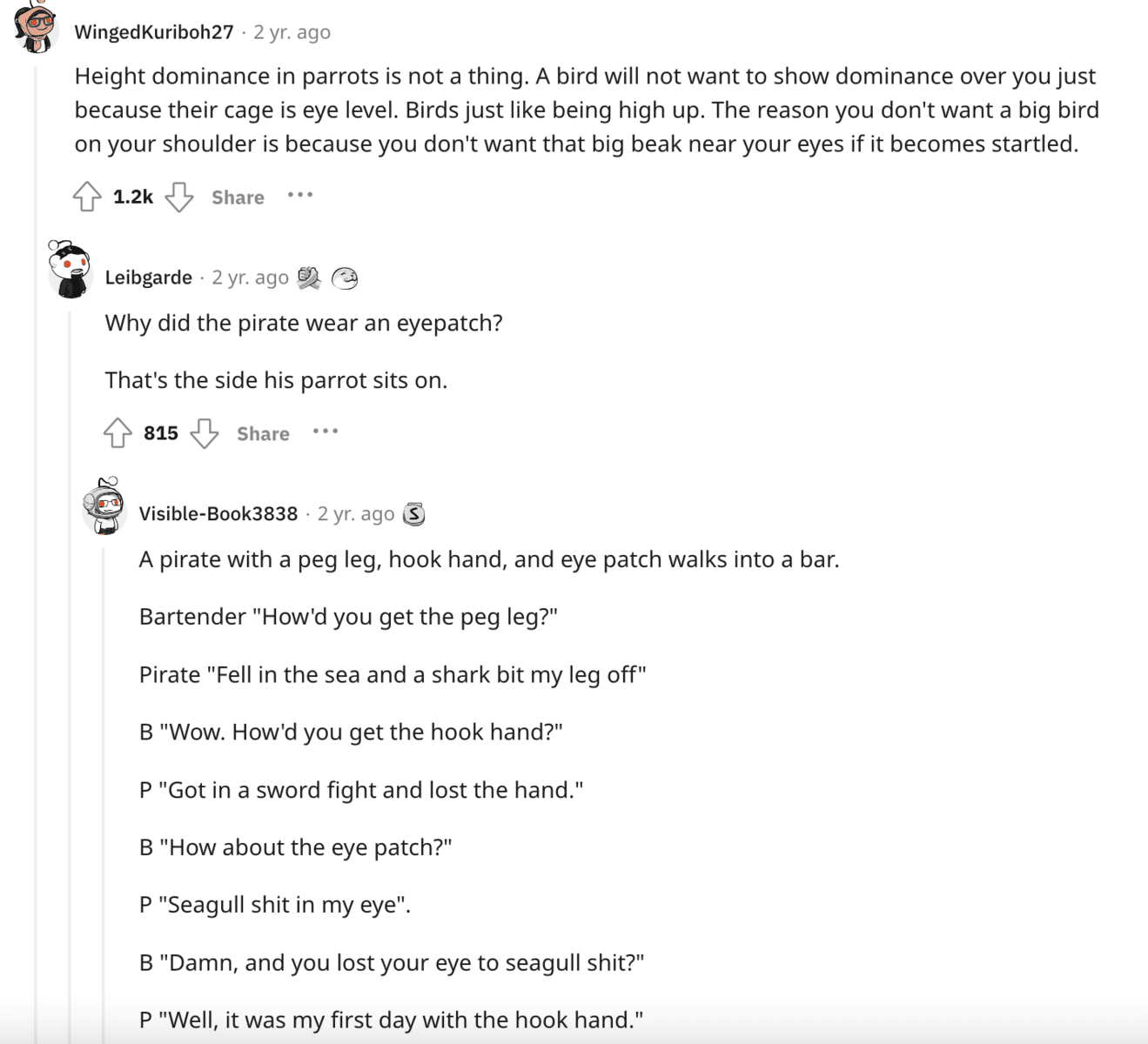
Parrots Don’t Have Height Dominance
If you’ve ever been told to put your parrot cage below eye level, so your bird doesn’t try and assert dominance over you, it’s a myth. Science debunked this myth when they discovered birds solely like being high up. They don’t try and assert dominance over you only because their cage is at eye level. The truest part about this is that you don’t want a big bird on your shoulder only because you don’t want a huge beak near your eyes. Imagine what happens when it gets startled? You’d end up with a patched eye, just like a pirate. You also don’t want a bird on your shoulder because you can’t read its body language, which allows your bird to communicate a feared or aggressive response. This is a way to set yourself up for a possible bite, which could potentially harm your eye or other parts of your face or head (Winged Kuriboh27).

We Don’t Have Taste Zones On Our Tongue
Do you remember coloring in the different “taste zones” on a picture of a tongue in school? It turns out that’s just a myth. Chemosensory scientists, or the scientists who study organs that respond to stimuli, discovered that taste sensors are distributed all over our tongues. We don’t have a section for salty, sweet, or sour. Our tongue does have certain areas that are more prone to picking up certain tastes, but these differences are minute. In 1901, scientist David P Hänig made this discovery, but the way he presented his findings changed the course of tongue history. Apparently, “it was more of an artistic interpretation of his measurements than an accurate representation of them. And that made it look as though different parts of the tongue were responsible for different tastes, rather than showing that some parts of the tongue were slightly more sensitive to certain tastes than others.” Because of this grave error, our science school teachers wrongly taught us about the tongue (Pinkie Toe).

Your Blood Is Red, Not Blue
In school, teachers taught that deoxygenated blood, which means the blood running in our veins before it’s exposed to air, is blue. As cool as it would be to have blue blood running through your veins, this is simply not true. Your blood is dark red. If you look at your veins, you might think your blood is blue. Our blood contains hemoglobin, a complex protein that contains iron. When iron reacts with oxygen, it turns it red. Even though the color of red may vary, depending on how far away from the heart it is, it’s never blue. It only appears blue because of how light travels through the skin. All of those diagrams they gave us about blue blood in science class was wrong. The only living creatures that have blue blood are octopi, crustaceans, and squid (Reddit).
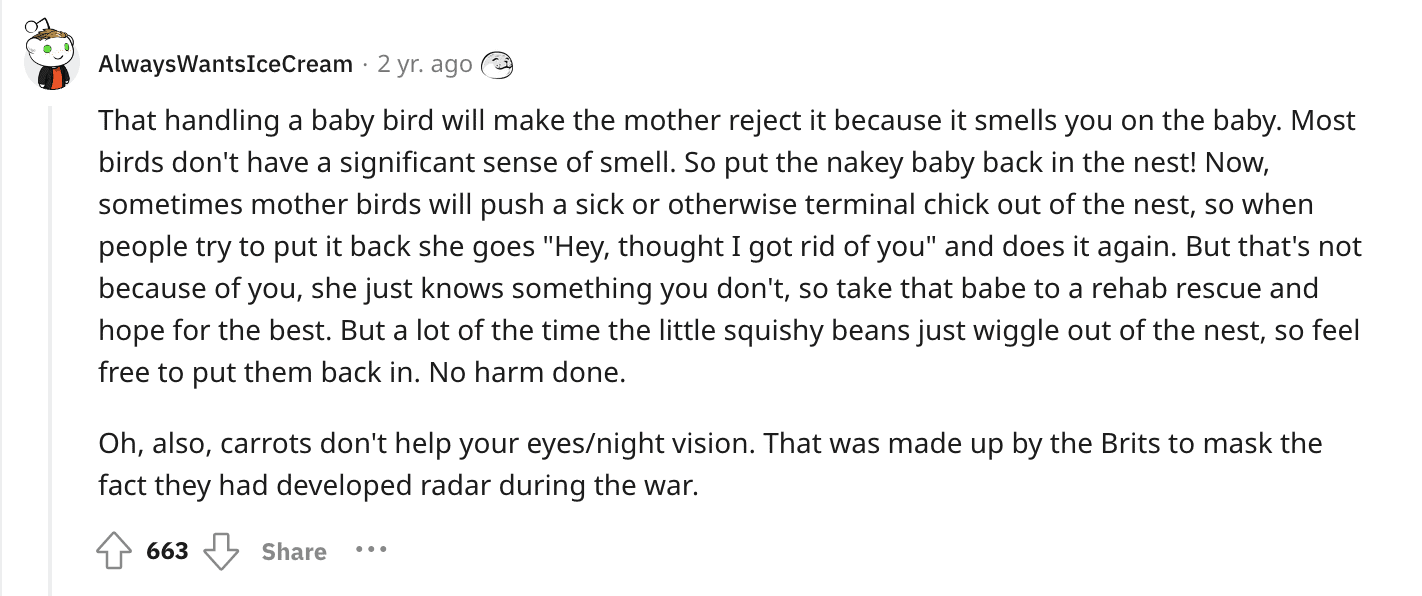
A Mother Bird Can’t Smell Human
Birds don’t have a significant sense of smell. They have simple, small olfactory nerves which limit their sense of smell. We don’t emit a strong enough smell for birds to pick up on. This is good news because if you’ve ever been told touching a baby bird will make the mother reject it, it’s just a myth. Popular science led us to believe that handling baby birds is a bad thing when in reality, most birds get rejected from their nest because they’re sick or weak. According to Miyoko Chu, a biologist at the Cornell Lab of Ornithology, “birds don’t have a very strong sense of smell, so you won’t leave a scent that will alarm the parent.” Typically, birds don’t abandon their young, and birds are as devoted to their young as humans are. The mother knows more than you. She knocked the bird out of the nest for a good reason, and it has nothing to do with humans (Always Wants Icecream)
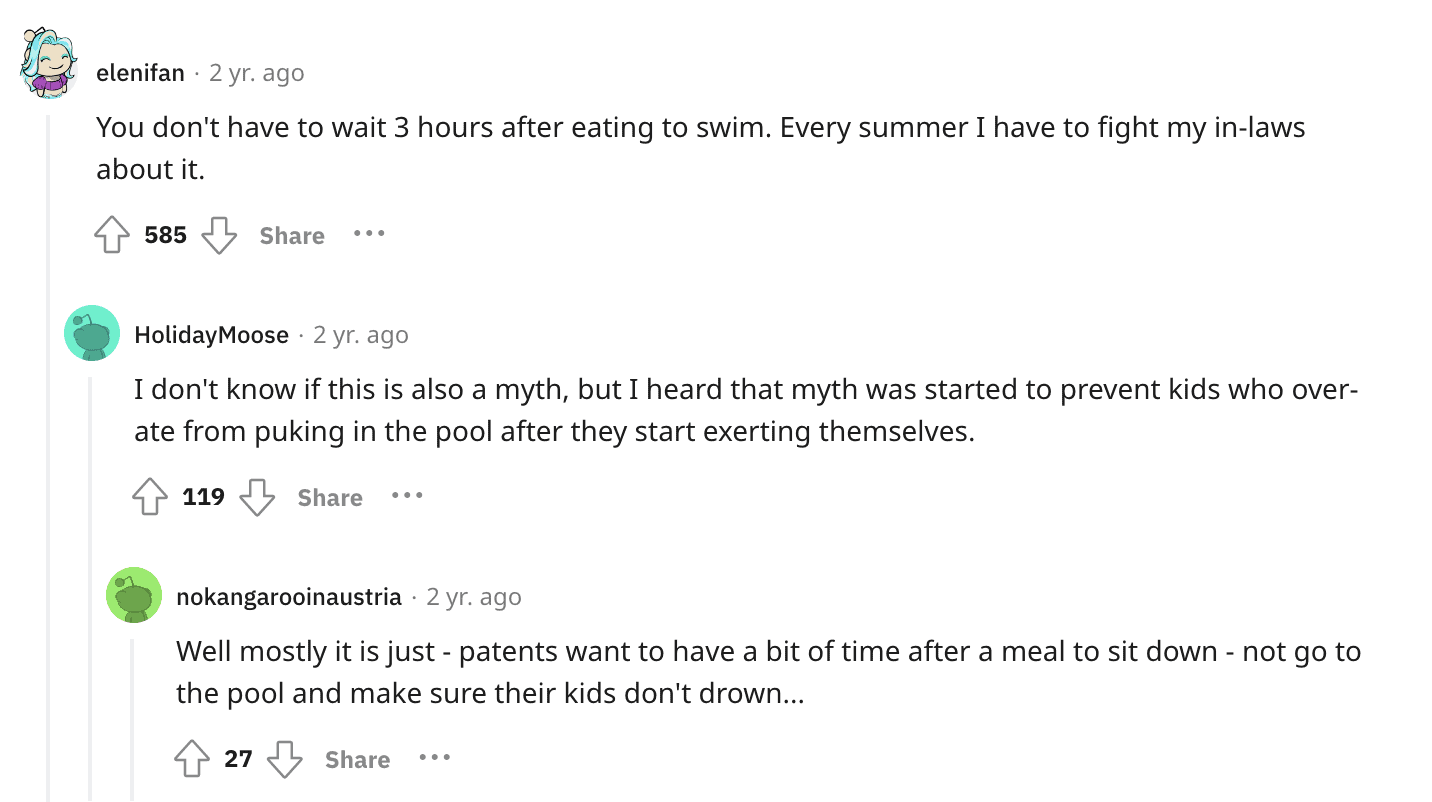
You Can Swim After You Eat
The only time you can’t swim is after drinking alcohol. There is no reason you can’t swim after eating, and it’s a myth that you can’t swim, otherwise your arms and legs will stop working. Dr. Messick said, “the body does supply extra blood to aid in digestion, but not enough blood to keep your arm and leg muscles from properly functioning. Your biggest danger related to eating and swimming is probably a minor cramp.” We’ve all dealt with a minor cramp here and there, and science tells us that our digestion is strong enough to keep on working while swimming, even right after we eat. The human body is strong enough to handle two processes at once. This is great news for those of you who love to eat while sitting on the beach. Go ahead and jump in those waves, nothing bad will happen (Elenifan).
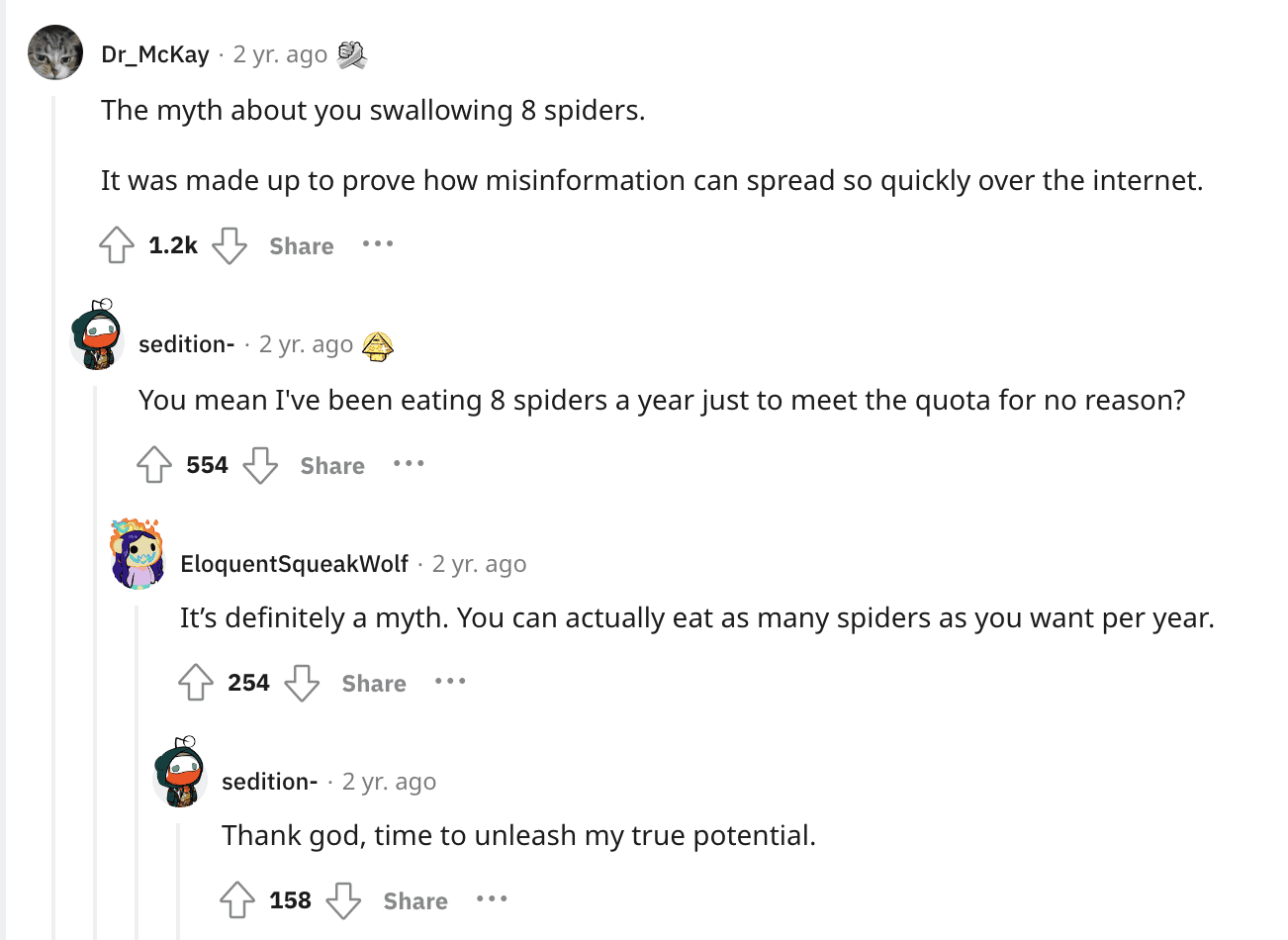
You Don’t Swallow Four To Eight Spiders A Year While You Sleep
Misinformation spreads quickly around the internet. You don’t swallow eight spiders a year while sleeping. Spiders don’t want to crawl into your mouth because it looks warm and inviting. They don’t have a death wish, as we’re led to believe. There’s no evidence or witnesses that say we swallow spiders while sleeping. Another myth, debunked by science, says we swallow up to 20 spiders in our lifetime. This simply isn’t true. There has never been a recorded science case anywhere in the scientific world, so you can get rid of that mask while you sleep. No critters are crawling inside anytime soon (Dr_McKay).

Crack Your Knuckles, It Doesn’t Lead To Arthritis
There’s zero scientific evidence that cracking your knuckles is bad for you, or that it leads to arthritis. The worst thing cracking your knuckles can do is annoy the people around you. When we crack our knuckles, we’re popping the synovial fluid, which is the fluid that helps us lubricate our joints. The worst thing that could happen is that you lose your grip strength over time. It also feels good to crack our knuckles, almost like a release of pain that’s built up over time. So crack away, and you won’t suddenly develop arthritis (Wanna Be A Viking).

You’re Not A Shark’s Favorite Snack
Sharks aren’t swimming around the ocean looking for humans. They’re not our biggest enemies, so next time you go swimming, don’t worry about sharks. When a shark attack happens, it’s always an accident. They mistake you for an animal they would normally eat, like a seal, they were curious, or they felt threatened. People are not part of their natural diet. Sharks should fear humans way more than we should fear them, considering the number of people that hunt for shark meat for food and leather. Also, to put it into perspective, out of the 300 species of sharks, only about a dozen have been involved in shark attacks (Pat The Pickle).
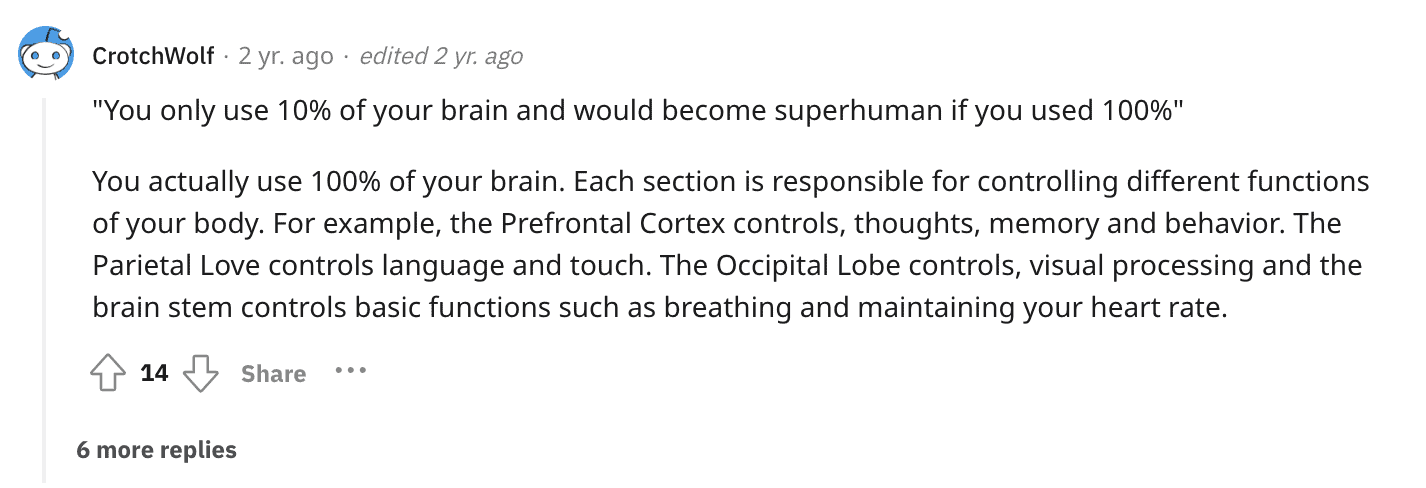
We Use 100% Of Our Brain
We’re not going to turn into a superhuman if we suddenly unlock a portion of our brain. We don’t use 10% of our brain, we use 100% of our brain. This myth caught traction after “the late 19th century in advertisements and brochures for self-help. Not to mention that Albert Einstein once said to a journalist that he only used 10% of his brain, as an answer to a question concerning his intelligence.” The theory kept spiraling after the movie Lucy tricked their viewers about the potential of unlocking 100% of your brain. It turns out we’ve already done that. We use different parts of our brain for language, memory, thoughts, vision, and touch. If we only used a small portion of our brain, we wouldn’t necessarily be the smartest people in the world, and would more likely be like primates than humans (Reddit).

Dairy Cows Udders Won’t Spontaneously Burst
You’ve probably heard that dairy cow’s udders have to be milked or else they’ll burst. This is not true. Cows only produce milk when they’re pregnant or lactating, just like humans, and it’s for their babies. We take the calf away so we drink the milk instead. If the cow is not milked, though, it would cause immense pain, bruising, and possibly infection. But the udders don’t burst. Still, the life of a dairy cow is brutally sad. It’s said that “in the middle of the 20th century, a dairy cow still pressed an average of 2,349 liters out of her udders – today, at 8,059 liters, it is well over three times that amount. Today’s dairy cow is trimmed for high performance, so she gives about 26 liters of milk a day.” These cows are bred specifically for milk, and though their udders don’t burst, they do live a life of pain. This is one of the biggest reasons people switch to a vegan diet or only drink plant-based milk like almond, soy, or coconut milk (Liefheid).
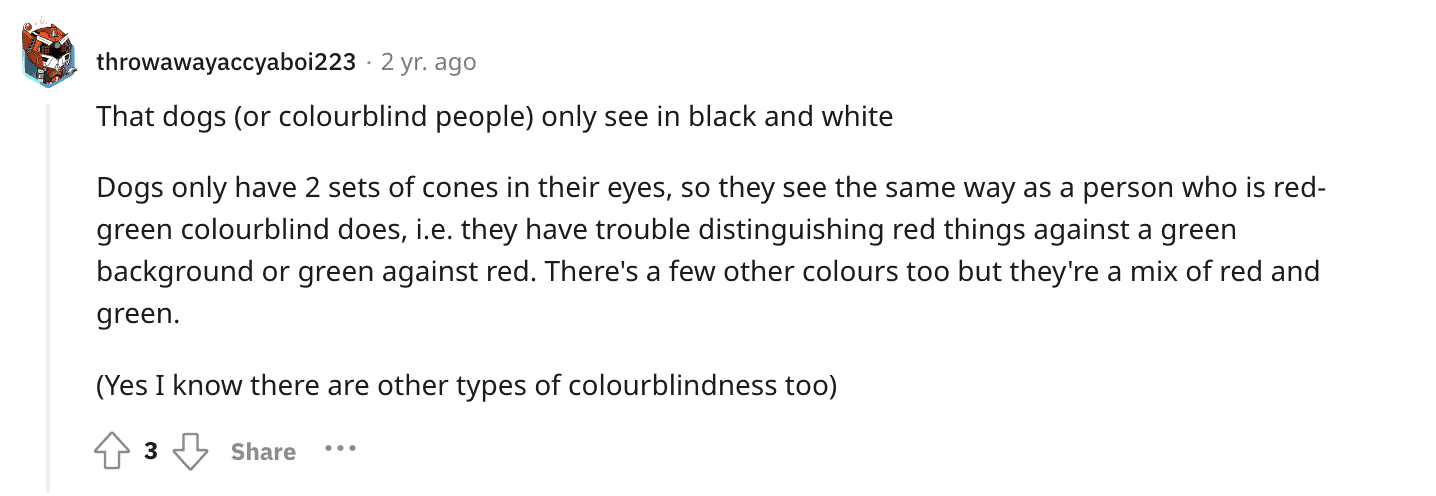
Dogs See In Color, Just Like We Do
Time and time again, we’ve heard that dogs only see in black and white. Because dogs only have two sets of cones in their eyes, they see the same way as humans who are colorblind. They have dichromatic vision. They can only discern between yellow and blue. The theory that dogs could only see in black and white was accepted for decades before science proved otherwise. This popular science myth started in 1937, with Will Judy‘s manual Training the Dog. Judy wrote, “it’s likely that all the external world appears to them as varying highlights of black and gray,” and the theory stuck ever since. The theory continued to hold its weight in the 1960s when a study wrongly concluded that only primates could see in color. Even though the color world of the dog is dimmed, they still see faded colors (Throwawayaccyaboi223)

Sorry To Tell You, But Coffee Doesn’t Sober You Up
How often have you been out at a party where someone’s chugging a cup of coffee to try and sober them up? They’re wasting their time. It doesn’t sober you up. The alcohol has to work its way through your system. Coffee isn’t a magical antidote that suddenly sucks the alcohol from your system. If it did, everyone would do it. The only thing that coffee will do is reverse the sedative effect of alcohol. Also, both coffee and alcohol will dehydrate your body, potentially making you feel more hungover the next morning, so make sure you drink a lot of water if you’re going to chug a mug of brew. Also, having caffeine with alcohol is dangerous. The caffeine may make you believe you’re not as drunk as you are, which could potentially lead to an accident (GoodDog_GoodBook123).
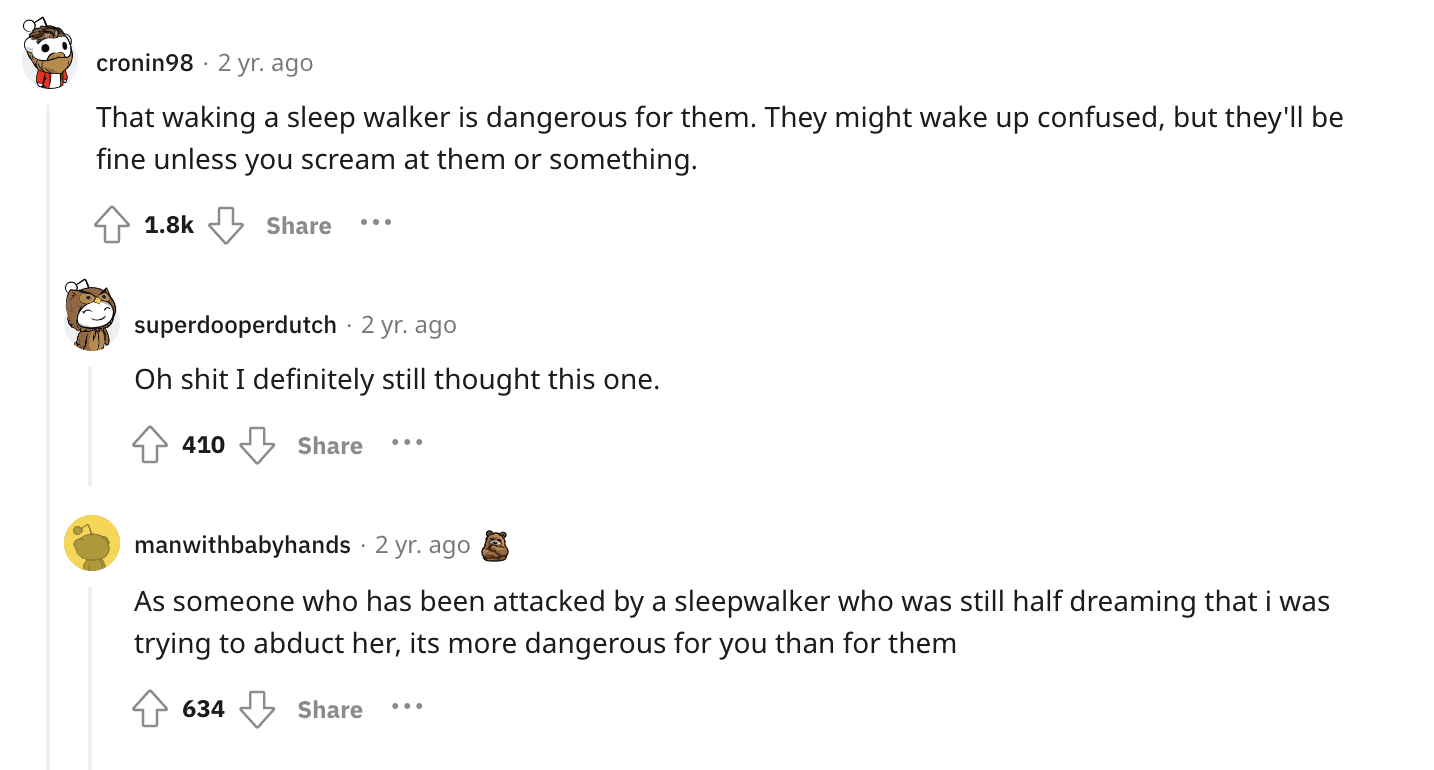
Go Ahead, Wake Up A Sleep Walker
Waking up a sleepwalker isn’t dangerous. If you do wake them up, they’ll wake up confused, but that’s about it. It’s better to wake them up to prevent an accident or stop them from hurting themselves. The best option is to slowly lead them back to bed. Because they’re in a deep REM sleep when they’re sleepwalking, you may find it difficult to wake them up. Sleepwalking happens in stage three of the sleep cycle, which involves the front part of your brain, which controls memory, is asleep, and the back part of your brain, which involves motor function, is awake. Sleepwalking people can open doors, pick up things, and open windows, which is where it may get dangerous (Cronin98).

Albert Einstein Was A Genius
The IQ of Einstein was extremely high, higher than most, unlike myths that told us he was uneducated. This myth may have spread worldwide to give us an excuse for laziness or unintelligence. He fell into the top 2% of people with high IQs. Apparently, “his IQ score is more than two standard deviations above the mean, only 2.2% of people have an IQ of 130 or more.” He wasn’t the smartest person in the world, however. The world-famous chess player, Bobby Fisher scored a higher IQ than Einstein. Scientists believed Einstein was on the autism spectrum. The genius disliked touch, had difficult times in social situations, and had trouble in other areas at school. After an investigation of Einstein’s brain following his death, they discovered he had thicker areas of his brain, which might explain his intelligence. Other than that, we can only strive to be as smart as Einstein, or else spend the rest of our lives in his shadow (Frizzhalo).

You Can Have A Cat If You Have A Baby, Don’t Worry
It sounds like an old wive’s tale that cats will try and suffocate your newborn baby by stealing their breath, while dogs will be protective. Even though it’s theoretically possible that a cat can kill your baby, just as anything is possible, it’s virtually never going to happen. As science studies cats, they’ve learned that cats are quiet creatures who love to keep to themselves, and will likely stay far away from a screaming newborn. The biggest threat to a baby is when a cat cuddles up too close to its face. Even then, it’s highly unlikely it would happen. The best way to have a cat and a newborn baby is to practice proper, responsible cat ownership (Anothertimesometime).

Don’t Let Your Pet Lick Your Wound
When you were younger, did you ever let your dog lick your bleeding wound because you thought it would help it heal? It’s likely it became infected soon after. There’s no reason to let your dog lick your bleeding wound. It’s an opening for infection and bacteria, and if your dog’s dirty mouth licks it, it’s going straight into your bloodstream. There’s a host of bacteria living in dog’s saliva, like Pasteurella, that can grow and replicate in areas of your body that don’t have air. This can lead to a severe infection that’s difficult to treat and needs prompt medical care, and in the worst case, you’ll have to get an amputation. In one example, a woman who let her dog lick her burn wound lost all of her fingers. Even though that’s a rare scenario, it’s best not to listen to the myth and instead clean your wounds with clean water and soap (Graysong263).

Scrambled Eggs Are Good For You, Don’t Worry
You might have heard that eggs are bad for your health, that they cause high cholesterol, and that they’ll raise your blood pressure and put you at risk for heart disease. Science does not back up this myth, and in reality, science proves that eggs are a great thing to add to your diet. As long as you’re not eating 20 eggs per day, you can reap the benefits of the protein and amino acids in eggs. Research says sticking to around 7 eggs per week is the best, and that consuming eggs may also help prevent stroke and degenerative eye conditions. So go ahead, fry up those eggs and enjoy them with your daily balanced breakfast (Your Temporary BFF).

Your Cellphone Won’t Turn Your Skin Blue
Harm from radiation from cellphones is just a myth. Even though cellphones do give off a small percentage of radiation, it’s not nearly enough to harm us. Research proves that “cell phones and cordless phones use radiofrequency radiation (RF) to send signals. RF is different from other types of radiation (like x-rays) that we know can be harmful.” Even though cellphones haven’t been around long enough for us to truly know the effects in years down the line, we don’t have to worry just yet. There are a lot of other things in this world that are a lot worse for us, like smoking and drinking alcohol (Interspace3029).

We all know you’re not supposed to smoke at a gas station. Previous reports show that people smoking next to gas stations have caused catastrophic explosions and fires. But what about use your cellphone? That’s another myth that people falsely spread around the world. The worst part about using your cellphone at a gas station is the risk of losing your attention at the pump, not the pump exploding. But where did this idea come from in the first place? It’s said that “one culprit could be the little shock you get when you shuffle across the carpet. While cell phones haven’t been shown to ignite fires at gas stations, static electricity has.” Avoid static electricity at all costs. The best thing to do when pumping gas is to put your cellphone away, just as you would do while driving, and carefully put the gas in your car (Reddit).

If You Drop Your Food, Don’t Eat It
People believe that if you pick up your food less than five seconds after dropping it on the floor, it’s still clean. There’s no proof in the scientific world that proves this, or that says it’s clean. According to a study conducted in 2006, where participators dropped bologna on the floor for less than five seconds, “a particular diarrhea-causing bacteria (Salmonella) can transfer from floor to food after just five seconds of exposure.” It disproves the rule in proving that five seconds is more than enough time for bacteria to transfer from the dirty ground to the piece of bologna. Another study in 2016 discovered that “watermelon had the most germs on it when it came back from the floor, implying that perhaps the flatter and wetter a food item, the easier it gets contaminated.” Next time you drop something, put it straight into the garbage (the-hoarding-dragon).

If you’re nearly blind, carrots aren’t the magical remedy that’ll give you 20/20 vision. But the vitamins in carrots will help improve your overall eye health. According to Winchester Hospital, “foods that are high in beta-carotene and vitamin A will only impact your vision if your body is deficient in vitamin A,” because an extreme lack of Vitamin A may cause blindness. So while stuffing your face with carrots won’t make your eyes strong enough to get rid of your glasses, they’ll at least give your body the vitamins and minerals it needs. Carrots also contain lutein, an antioxidant, and “foods rich in lutein increase pigment density in the macula. The greater pigment density in the macula, the better protected your retina is and the lower your risk for macular degeneration.” Eat your carrots to protect your eyes from future disease (KurtyVonougat)

